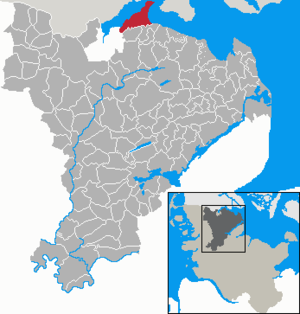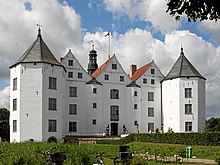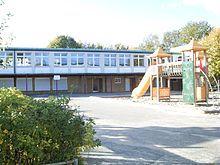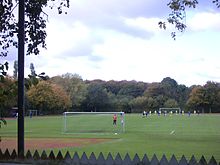Glücksburg (Baltic Sea)
| coat of arms | Germany map | |
|---|---|---|

|
Coordinates: 54 ° 50 ' N , 9 ° 33' E |
|
| Basic data | ||
| State : | Schleswig-Holstein | |
| Circle : | Schleswig-Flensburg | |
| Management Community : | Flensburg | |
| Height : | 19 m above sea level NHN | |
| Area : | 39.7 km 2 | |
| Residents: | 6114 (Dec. 31, 2019) | |
| Population density : | 154 inhabitants per km 2 | |
| Postal code : | 24960 | |
| Area code : | 04631 | |
| License plate : | SL | |
| Community key : | 01 0 59 113 | |
City administration address : |
Schinderdam 5 24960 Glücksburg (Baltic Sea) |
|
| Website : | ||
| Mayoress : | Kristina Franke (independent) | |
| Location of the city of Glücksburg (Baltic Sea) in the Schleswig-Flensburg district | ||

Glücksburg (Baltic Sea) ( Danish : Lyksborg , Low German : Glücksborg ) is a small town in Schleswig-Holstein on the Flensburg Fjord on the fishing peninsula near the regional center of Flensburg . It is the northernmost city in Germany.
geography
The small town of Glücksburg is located east of the city of Flensburg. Meierwik, which belongs to Glücksburg, is completely fused with Flensburg's Mürwik district . In the north-eastern part of Glücksburg lies the Holnis peninsula with its steep coast and a salt marsh with an important breeding colony for sea birds . The entire peninsula that extends about five kilometers to the northeast in the Flensburg Fjord is partly under nature conservation .
City and districts
Glücksburg consists of the town of Glücksburg, with its districts Alt-Glücksburg, Sandwig (Sandvig) with Quellental , Schwennau ( Svendå ) and Bremsberg ( Bremsbjerg ) and Ulstrupfeld ( Ulstrupmark ). The district Rüdeheck ( Rydeled ) has also grown together with the actual city . There are also the districts of Meierwik (Mejervig) , Schausende (Skovsende) , Holnis (Holnæs) , Drei (Draget) , Bockholm (Bogholm) and Iskiersand ( Eskærsande ). (Iskiersand is a district shared with the neighboring Munkbrarup .) Other smaller places that belong to Glücksburg are Wahrberg , Schiedenhohlweg, Kobbellück, Neufeld , Ruhetal and Mittkoppel .
Neighboring communities
In addition to Flensburg, neighboring communities are also Wees and Munkbrarup with Bockholmwik .
history
The four large stone graves near Glücksburg and the large stone grave Bockholm date from the Neolithic Age .
In the Middle Ages, the small village of Skovby (about Walddorf ) developed in the area of today's Hindenburgplatz.
The area experienced further settlement through the establishment of the Cistercian monastery Rüde , Rus Regis (also called Rudekloster) in 1209, which was initially located as Michaelis monastery in Schleswig and then in Guldholm near Böklund (see also Cistercians ). The Rüde monastery owned extensive land in the immediate vicinity as well as some free float. Place names with Munk (Danish for monk) such as Munkbrarup , Munkwolstrup (municipality of Sankelmark ) or Munkmühle (near Rinkenis on the other bank of the Flensburg Fjord) still indicate this connection.
After the Reformation the monastery was closed. When the country was divided in 1544, ownership first fell to Duke Johann the Elder and, after his death in 1581, to his nephew Johann the Younger , who moved his main residence from Sønderborg here. The ruins of the monastery were flooded and a moated castle was built in the middle of the resulting lake - one of the most famous in Germany to this day. The old monks' cemetery is still under the castle lake. The vaults of the old monastery tavern in Große Straße and the old yew trees in Rathausstraße 36 may still come from the monastery period in Glücksburg.
The noble family of Glücksburg ( Holstein-Sonderburg-Glücksburg ), which to this day represent the kings of Denmark (since 1863) and Norway (since 1905) and from 1863 to 1973 also in Greece, is a line of the House of Oldenburg . After the death of the "separated Duke" Johann in 1622, his possessions were distributed among five sons. The western part with the old monastery, Glücksburg Castle and the Sundewitt part of the country north of the Flensburg Fjord came to Duke Philipp, who established the older Sonderburg-Glücksburg line. This died out in 1779. This dissolved the last of the divided Sønderborg duchies. Glücksburg remained the widow's seat of the last duchess until 1825, when it was transferred from the Danish king to the noble officer Wilhelm von Sonderburg-Beck, who came from a younger branch line of the Sonderburg main house that went bankrupt in 1667 (just like the Augustenburg family) ). The name Glücksburg was transferred to this line of the Oldenburg house, which later became Christian IX. took over the Danish royal throne.
In the 1850s, Glücksburg was the preferred summer residence of the Danish King Friedrich VII , the last offspring of the older male line of the Oldenburg royal family. Glücksburg had now become a stain developed the common law had some retail and commercial freedoms. After the sudden death of the king at Glücksburg Castle in 1863, Christian von Holstein-Sonderburg-Glücksburg, who had been nominated in 1852, succeeded him. As early as 1864, however, the German-Danish War broke out between Denmark on the one hand and Prussia and Austria on the other, and Glücksburg became Prussian like the entire Duchy of Schleswig . In 1871 Glücksburg became part of the German Empire and remained so after the referendum in Schleswig in 1920. On April 1, 1900, Glücksburg was granted city rights .
There has been a flourishing lido in Glücksburg-Sandwig since the imperial era .
The city of Glücksburg has been investing in "Stadtausbau-Ost" since the 1960s, which later became the district of Bremsberg . Today around the eponymous hill Bremsberg (40 m) live up to 1000 inhabitants. In 1995 artefact was inaugurated here, a center for applied technology and development cooperation. The so-called Power Park on the west side of the hill is dedicated to environmental management , renewable energies and "technological progress in the use of energy resources". The Bremsberg district has continued to be expanded significantly since the 2000s.
Glücksburg has had bilingual place-name signs since December 2016; under the German Glücksburg stands the Danish Lyksborg .
Historical society Glücksburg
On November 18, 1987, descendants of the ducal family and Helmut Ries founded the Glücksburg Historical Society (HGG) in Glücksburg Castle, which serves to maintain the tradition of Glücksburg town and Castle. It deals particularly with the history of the castle and its inhabitants and presents itself to the public with lectures and events in Glücksburg Castle.
religion
In Glücksburg there are Protestant congregations of the Evangelical Lutheran Church in Northern Germany and the Danish Church in Southern Schleswig . The German-speaking Evangelical Lutheran parish used the castle chapel of Glücksburg Castle until the 1960s. Between 1963 and 1965 the Church of the Resurrection was built on the edge of the cemetery . The Danish Church in Glücksburg on Paulinenallee was inaugurated in 1954.
The Catholic Church of St. Laurentius of the parish of St. Mary's Sorrowful Mother in the dean's office in Flensburg is located on Bergstrasse .
The New Apostolic congregation was closed in October 2006 for financial reasons and incorporated into the New Apostolic Church in Mürwik .
politics

Since January 1st, 2008 Glücksburg has formed an administrative community with the neighboring, independent city of Flensburg , which also carries out the administrative business for Glücksburg, see Town Hall (Flensburg) . The town hall of Glücksburg , until then the seat of the city administration, was demolished in 2011.
Since around 2015, Flensburg has been so densely populated that it is no longer possible to create sufficient new living space there. This inhibits the growth of the city and the surrounding area; the delicate topic of incorporating Glücksburg therefore plays a role again in the discussion.
City council
The 27 seats of the city council have been distributed as follows since the 2018 local elections:
| Political party | CDU | SPD | Green | SSW | FDP |
|---|---|---|---|---|---|
| Seats | 10 | 5 | 5 | 4th | 3 |
mayor
Since the population of Glücksburg is below 8,000, the full-time position had to be given up in the meantime. In the constituent meeting of the city council in 2008, an honorary mayor was elected. Since 2013, municipalities with more than 4,000 inhabitants can elect a full-time mayor again. The election took place in 2013. As a result, Glücksburg has had a full-time mayor again since January 1, 2014. As a result, the city council re-elected a mayor.
- 1889–1914: Asmus Bunzen ( Free Conservative Party )
- 1914–1919: Curt Fuhrmann
- 1920–1922: Arthur Hardenberg
- 1923–1924: Johannes Krancke
- 1926–1932: Christian Carsten Christiansen
- 1932–1933: Wilhelm Klein (DNVP)
- 1933–1938: Harald Boysen ( NSDAP )
- 1938–1945: Carl Brandes (NSDAP)
- 1945–1947: Victor Graf von Reventlow-Criminil ( SSW )
- 1947–1950: Kai-Uwe von Hassel ( CDU )
- 1950–1960: Philipp Petersen (first independent, then CDU )
- 1960–1977: Hans Hansen ( CDU )
- 1977–2001: Hans-Werner Petersen (first independent, then CDU )
- 2001–2006: John Witt (independent) (1st direct election)
- 2006–2007: Ellen Hackelsperger (honorary mayor ( CDU ))
- 2008-2013: Dagmar Jonas (honorary mayor ( CDU ))
- since 2014: Kristina Franke (full-time mayor) (independent)
Mayor
- April 1950: Otto Herms
- 1950–1963: Kai-Uwe von Hassel
- 1963–1982: Prince Friedrich Ferdinand of Schleswig-Holstein-Sonderburg-Glücksburg
- 1982–1986: Gustav Backen
- 1986–2003: Elke von Hassel
- 2003–2007: Ellen Hackelsperger
- 2014–2018: Dagmar Jonas
- 2018–2019: Christina Kieback
- since 2019: Gerd Pirschel
coat of arms
Blazon : "In gold, a vertical red grate with the handle down."
Town twinning
- Ærøskøbing (Denmark) since 1970
- Göhren (Rügen) since October 3, 1990
Sponsorships
- Supply ship Glücksburg of the German Navy from 1967 until decommissioning in 2001
- Lufthansa CityLine's Bombardier CRJ900 named "Glücksburg" on July 31, 2007
traffic
There is an hourly bus connection to Flensburg through the Schleswig-Flensburg transport association . The previously existing small train connection between Flensburg, Glücksburg and Kappeln was shut down in 1952. The historic ZOB , the former train station of the Flensburger Kreisbahn, is located in the center of the city . Today, in addition to the bus stop, it is home to the city library. The actual center of the village is on Rathausstraße, where you can find a few shops and a supermarket. The next larger center is with the Twedter Plack , which many Glücksburg residents also use as a shopping opportunity, not far away in Flensburg-Mürwik . The Twedter Plack as well as the Flensburg city center can be reached directly with bus line 21 .
Glücksburg is also connected to some long-distance cycle routes, including a. to the Baltic Sea Cycle Route , which circles the Baltic Sea once within the European EuroVelo network .
Tourism and sightseeing
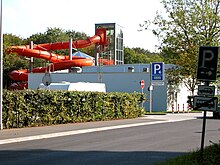
The list of cultural monuments in Glücksburg (Baltic Sea) includes the cultural monuments entered in the list of monuments of Schleswig-Holstein.
Tourism in Glücksburg is of great importance for the local economy. Today there are several hotels in all categories as well as numerous guest houses, holiday apartments and campsites in Glücksburg. The number of overnight stays in 2005 was a good 250,000. As early as 1872, a Baltic Sea lido was set up in the Sandwig district . There are also excellent, sometimes very lonely beaches in the area, such as Solitüde , or the lonely natural beach at Quellental . The beach at Drei bei Holnis is also popular with bathers.
Quellenental is a destination not only because of its natural beach. This is where the Hanseatic Yacht School is located. The largest and oldest yacht school in Germany is located as the northernmost of the three schools of the German Hochseesportverband Hansa e. V. on the Flensburg Fjord . The Flensburg Sailing Club (FSC) is based in the same port . The public Menke planetarium , which is operated by the Flensburg University of Applied Sciences , is also located on the edge of the Quellenental .
In addition, one of the largest forest areas in Schleswig-Holstein is located around Glücksburg. On the edge of the Glücksburg Forest, there has been a forest museum in the Glücksburg Forest since November 2009 . In March 2007 the Fördeland-Therme , a new adventure pool and wellness center, was opened as a replacement for the sea water wave pool completed in 1971, which in its new form without a wave pool has been competing with the campus pool on the campus of the Flensburg University of Applied Sciences and the European University of Flensburg for several years got to.
The Glücksburg Castle is a historic water tower. The picturesque destination was chosen twice as a stamp motif. The building of the late Renaissance belongs to a foundation today. It was built in 1582 under Duke Johann von Schleswig-Holstein-Sonderburg . The Glücksburg Rosarium was opened in 1991 in a former part of the castle park , which houses over 500 varieties of roses on an area of around one hectare, including mainly historical varieties and Germany's largest collection of English roses . A little further away from the castle is the Erlkron tower ruin , which was made from stones from the former Duburg .
The Lyksborg Historiske Værksted project of the local Danish school has existed since 1996 . A replica of an Iron Age village is being worked on right next to the school. The tourism concept also likes to refer to the neighboring Mürwik , as well as to Flensburg in general.
Regular events
- Ostseeman Triathlon (since 2002)
- Glücksburger Strandmeile (annual festival, 2002 to 2012)
- Glücksburger Fördelauf (since 1987)
- Concerts of the Schleswig-Holstein Music Festival
- Rose festival in the rosarium with free skating of the Glücksburg rose queen and rose princess (since 2005 always on the last weekend in June)
- DLRG funding crossing in July
- Christmas market in the castle courtyard (always on the first weekend of Advent)
language
In Glücksburg, High German is primarily spoken , with Low German and Danish as well . A Danish kindergarten, a Danish school and a Danish church have been set up for the Danish minority.
education
The Schule am Kegelberg is the town's primary and special school . Up until the end of the nineties there was also a secondary school , which was closed due to insufficient student numbers. The Danish minority maintains the six-class Lyksborg Skole on Gorch-Fock- Strasse. There is also an adult education center in Glücksburg.
Furthermore, there are a total of three kindergartens in Glücksburg - two German-speaking ones, one of which is Protestant, and one Danish. The Protestant kindergarten, like the Danish-speaking one, is located on Glücksburger Petersenallee, while the city's ADS kindergarten is located on the Bremsberg (ADS = Arbeitsgemeinschaft Deutsches Schleswig).
The small city library in Glücksburg is supported by the lending and supplementary library in Flensburg.
Sports
Sports facilities
Glücksburg maintains a sports field at the entrance to the village, which has been converted into a small stadium and is one of the most beautiful facilities in the Schleswig-Flensburg district. In 2015 the small stadium was named "Schwennau-Arena". In addition to the small stadium, there is a spacious grand pitch for the football department as a training ground, which was built in 1982. In 1983 a modern multi-purpose hall was inaugurated on an adjacent former soccer field, which is called the Rudehalle . Some branches use the gymnasium and sports hall of the local elementary school. A landmark of the association is the old gym , which was built in the 1920s and is still in use today.
TSV Glücksburg 09
The gymnastics and sports club Glücksburg 09 e. V. celebrated its centenary in 2009. The association is also popularly known as NullNeun . Glücksburg 09 maintains the fields of basketball (newly formed), music ( fanfare parade ), football , cross-country skiing / triathlon , athletics , handball , gymnastics and gymnastics , karate , badminton , volleyball .
The handball department had great success in the 1980s and 1990s, not least of all under the syndicate with the neighboring club TSV Munkbrarup . The then SG Glücksburg-Munkbrarup made it into the handball regional league. Glücksburg 09 is also known for its good youth work in handball and was even able to produce junior national players. The athletics division of the club, which has a large number of members, especially in the junior division, is no less successful. Germany's number 1 sport, football, traditionally has a hard time in Glücksburg. It was only rarely possible to fill all youth classes or to get beyond the district league in the men's area. In the meantime, the short-term successful first team has disbanded. For two years, the football department was completely in the SG Nordangeln , an amalgamation of a total of five sports clubs. Since 2011 there has been an independent men's department again, while the young people from Glücksburg continue to play at SG Nordangeln 05. In the 1950s, FC Glücksburg existed parallel to TSV , but it dissolved again after a few years. The future professional football player Heiko Petersen emerged from the youth department of Glücksburg 09 . The basketball department of the club has been newly formed or is still under construction. Jan Holpert started playing handball at “NullNeun”.
armed forces
In the last days of the war, the barracks in the Meierwik district belonged to the Mürwik special area . In the 1950s, the Meierwik barracks were occupied by the Bundeswehr . Since then, Meierwik has been the location of the Navy's fleet command . The entire German fleet was managed operationally and administratively from here. As part of the realignment of the Bundeswehr , the fleet command was disbanded on September 30, 2012. The Glücksburg branch of the naval command is located in the barracks until the site is closed . In addition to Meierwik, the Flensburg-Glücksburg site also includes the remaining military installations at the Flensburg-Mürwik base .
Personalities
Honorary citizen
- 1914: Asmus Bunzen
- 1918: Christian Schmid
- 1922: Siegmund Satz
- 1924: Georg Nicolaus Kruse
- 1963: Kai-Uwe von Hassel
- 1982: Prince Friedrich Ferdinand of Schleswig-Holstein-Sonderburg-Glücksburg
Personalities from Glücksburg
- Sophie Hedwig of Schleswig-Holstein-Sonderburg-Glücksburg (1630–1652), Holstein princess, designated Duchess of Saxony-Zeitz
- Sophus Hansen (1871–1959), painter
- Kai-Uwe von Hassel (1913–1997), politician (CDU), was, among other things, Mayor of Glücksburg, Prime Minister of Schleswig-Holstein, Federal Minister, President of the Bundestag
- Wolfgang Heibges (1922–2005), retired frigate captain. D. and commander of the submarine U 999 (1944)
- Horst-Helmut Wind (1927–2009), German naval officer, most recently flotilla admiral in the German Navy
- Hans Hansen (1926–2007), (sports official), President of the German Sports Confederation (DSB) 1986–1994
- Gui Bonsiepe (* 1934), designer and design theorist
- Wolfgang Konrad (* 1941), violinist, inventor and project developer
- Heiko Petersen (* 1980), soccer player
Personalities who worked in Glücksburg
- Helmut Ries (1920–2009), doctor, author, founder of the Glücksburg Historical Society
literature
- Dietrich Weldt: Ostseebad Glücksburg. Castle, landscape, city. Husum Verlag, Husum 1987, ISBN 978-3-88042-395-4 .
- Dietrich Weldt: Glücksburg. Seaside resort between the castle and the beach. Husum Verlag, Husum 2007, ISBN 978-3-89876-146-8 .
- Harald Torp: Glücksburg in the war and post-war period, excerpts from the church chronicle of the parish of Glücksburg , in: Yearbook of the Angler Heimatverein vol. 25 (1961) pp. 37–46.
Web links
Individual evidence
- ↑ North Statistics Office - Population of the municipalities in Schleswig-Holstein 4th quarter 2019 (XLSX file) (update based on the 2011 census) ( help on this ).
- ↑ Quellenental is probably not an official district, even if Quellental is described as such on the Glücksburg Tourist Information website; See beaches in Glücksburg and on the Flensburg Fjord , accessed on: May 22, 2015 and LG Flensburg: "sandwig.de" InternetArchiveBot ( memento from April 14, 2015 in the Internet Archive ), from: January 8, 2002; Retrieved on: May 22, 2015
- ↑ Anders Bjerrum, Kristian Hald and Peter Jørgensen: Sydslesvigs stednavne 7.1, Akademisk forlag 1979, page 107
- ↑ M. Mørk Hansen: Kirkelig Statistics over Slesvig Stift: Med historiske og topografiske bemærkninger, 2nd volume, Kjøbenhavn 1864, page 250
- ↑ LG Flensburg: "sandwig.de" ( Memento of the original from April 14, 2015 in the Internet Archive ) Info: The archive link was automatically inserted and not yet checked. Please check the original and archive link according to the instructions and then remove this notice. , dated: January 8, 2002; Retrieved on: May 22, 2015
- ↑ Falk maps Hello: Flensburg and around 2013 , 7th Edition
- ↑ Anders Bjerrum, Kristian Hald and Peter Jørgensen: Sydslesvigs stednavne 7.1, Akademisk forlag 1979, page 69
- ↑ LG Flensburg: "sandwig.de" ( Memento of the original from April 14, 2015 in the Internet Archive ) Info: The archive link was automatically inserted and not yet checked. Please check the original and archive link according to the instructions and then remove this notice. , dated: January 8, 2002; Retrieved on: May 22, 2015
- ↑ Falk maps Hello: Flensburg and around 2013 , 7th Edition
- ↑ Website of the city of Glücksburg ( Memento of the original from May 18, 2008 in the Internet Archive ) Info: The archive link was inserted automatically and has not yet been checked. Please check the original and archive link according to the instructions and then remove this notice.
- ↑ Glücksburg now also in Danish. In: Flensborg Avis. Flensborg Avis AG, December 23, 2016, accessed on July 26, 2019 .
- ↑ Glücksburg / Lyksborg is now bilingual. In: SH Ugeavisen. SH-UgeAvisen A / S, December 22, 2016, accessed on July 26, 2019 .
- ^ Ev-Luth. Church district Schleswig-Flensburg: parish Glücksburg
- ^ Dansk Kirke i Sydslesvig: Om menigheden og dens historie
- ↑ Catholic Church - Deanery Flensburg: Glücksburg-St. Laurentius , accessed January 5, 2013
- ^ New Apostolic Church in Northern Germany
- ↑ Results of local elections 2018. (pdf) Stadt Glücksburg, p. 1 , accessed on January 16, 2019 .
- ↑ Always a popular and fine address ( Memento of the original from March 5, 2015 in the Internet Archive ) Info: The archive link was automatically inserted and not yet checked. Please check the original and archive link according to the instructions and then remove this notice. . In Strandhotel Glücksburg , accessed on March 8, 2015
- ↑ Flensburger Tageblatt : Housing Contingents: City-Surrounding-Peace Before the End , from: June 4, 2015; Retrieved on: June 4, 2015
- ↑ Schleswig-Holstein's municipal coat of arms
- ↑ Baltic Sea Cycle Route - Baltic Sea Schleswig Holstein. Retrieved May 6, 2017 .
- ↑ translator2: EuroVelo 10 - EuroVelo. Retrieved May 6, 2017 .
- ↑ Flensburger Tageblatt : The thermal baths and the campus pool: Does Glücksburg's indoor pool have to close? , from: January 16, 2015, accessed on: January 16, 2015
- ↑ [1] and 2015-08 reconstruction Schwennau arena , each accessed on: August 8, 2018
- ↑ See source: Chronicle 75 Years Glücksburg 09, page 41

